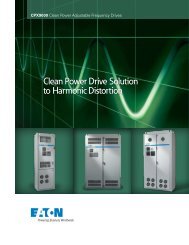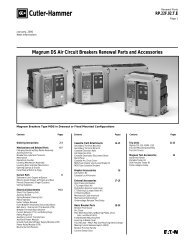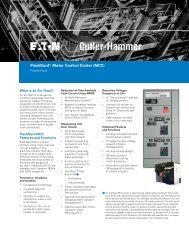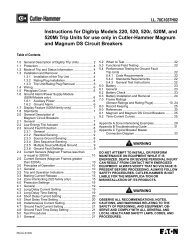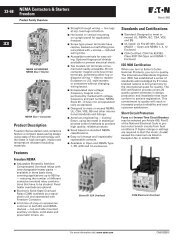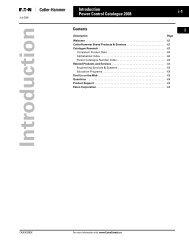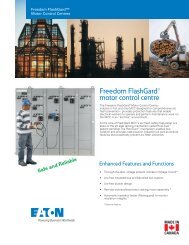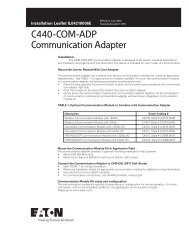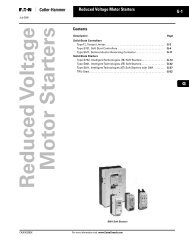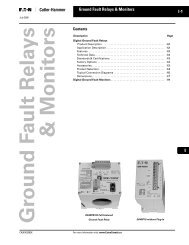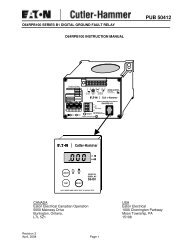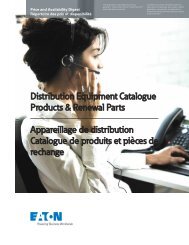Standard Specification for Type PSE Deadfront ... - Eaton Canada
Standard Specification for Type PSE Deadfront ... - Eaton Canada
Standard Specification for Type PSE Deadfront ... - Eaton Canada
You also want an ePaper? Increase the reach of your titles
YUMPU automatically turns print PDFs into web optimized ePapers that Google loves.
holders to swing inside the enclosure.<br />
4. Finish<br />
Full coverage at joints and blind areas shall be achieved by<br />
processing enclosures independently of components such<br />
as doors and roofs be<strong>for</strong>e assembly into the unitized<br />
structures.<br />
All exterior seams shall be sanded or ground smooth <strong>for</strong><br />
neat appearances.<br />
To remove oils and dirt, and to <strong>for</strong>m a chemically and<br />
anodically neutral conversion coating to improve the finishto-metal<br />
bond, and to retard underfilm propagation of<br />
corrosion, all surfaces shall undergo a chemical cleaning<br />
and phosphatizing process be<strong>for</strong>e any protective coatings<br />
are applied.<br />
The finishing system shall be applied without sags or runs<br />
<strong>for</strong> a pleasing appearance.<br />
After the enclosure is completely assembled and the<br />
components (switches, bus, etc.) are installed, the finish<br />
shall be inspected <strong>for</strong> scuffs and scratches.<br />
Blemishes shall be carefully touched up by hand to restore<br />
the protective integrity of the finish.<br />
Unless otherwise specified, the color shall be Munsell No.<br />
7GY3.29/1.5, dark green.<br />
To insure that the finishing system is capable of resisting<br />
corrosion, the manufacturer shall provide on request,<br />
certification that representative test panels, protected by<br />
the manufacturer's finish system, have passed the following<br />
tests:<br />
a) Salt spray (relates to coastal environments and/or<br />
presence of snow-melting salts or fertilizers). Scribe to<br />
bare metal and test <strong>for</strong> 2000 hours in a 5% salt spray<br />
per ASTM B-117. Loss of adhesion from bare metal<br />
should not extend more than 1/8" from the scribe.<br />
Underfilm corrosion should not extend more than 1/16"<br />
from the scribe.<br />
b) Crosshatch adhesion (relates to adhesion after<br />
scratching of the finish). Scribe to bare metal a cross<br />
hatch pattern of 100 1/16" wide squares. Apply Scotch<br />
710 tape and rapidly remove. There should be 100%<br />
adhesion to the bare metal and between layers.<br />
c) Humidity (relates to environments with high humidity).<br />
Test of 1000 hours subject to 100% humidity at 45-50<br />
degrees C per ASTM D-2247. There should be no<br />
blisters.<br />
d) Impact (relates to transit and handling damage and<br />
abuse by the public). Impact the test panel with a 160<br />
in-lb. falling dart per ASTM D-2794. There should be no<br />
cracking or chipping of the paint on the impact side of<br />
the test panels.<br />
e) Oil resistance (relates to probable contact with mineral<br />
oil). Immerse two test panels in mineral oil <strong>for</strong> 3 days,<br />
one at room temperature and one at 100 degrees C<br />
(212 degrees F). There should be no apparent changes,<br />
such as color shifts, blisters, loss of hardness or<br />
streaking.<br />
f) Ultraviolet Accelerated Weathering Test (relates to<br />
exposure to sunlight and rainfall, loss of gloss, color<br />
fading and chalking). Continuous exposure to ultraviolet<br />
light <strong>for</strong> 500 hours per ASTM G-53 with a cycle of 4<br />
hours ultraviolet followed by 4 hours of condensation.<br />
Loss of gloss shall not exceed 50% of original per<br />
ASTM D523.<br />
g) Water Resistance (relates to rainfall or dew). Immerse<br />
a test panel in distilled water <strong>for</strong> 3 days at room<br />
SECTION SB-2A-210<br />
<strong>PSE</strong> TYPICAL SPECIFICATION<br />
APRIL 1999<br />
PAGE 3<br />
temperature. There should be no apparent changes,<br />
such as blistering, color shift, loss of hardness or<br />
streaking.<br />
h) Adhesion Fed. Spec 141A, Method 6301.1 (relates to<br />
adhesion after scratching the finish). Immerse test<br />
panel in distilled water <strong>for</strong> 24 hours. Make two parallel<br />
scratches 1" apart. Apply Scotch 710 tape and rapidly<br />
remove. There should be 100% adhesion to the bare<br />
metal and between layers.<br />
i) Abrasion Test - Taber Abrader (relates to wear<br />
encountered during installation). Prepare a panel coated<br />
with the component of the finish intended to provide<br />
abrasion resistance. Test using a CS-10 wheel, 1000<br />
gram weight, 3000 cycles, per Fed. Spec. 141, Method<br />
6192. This provides a comparative test between<br />
samples. To guard against corrosion, all hardware<br />
(including door fittings, fasteners, etc.), all operatingmechanism<br />
parts, and other parts subject to abrasive<br />
action from mechanical motion shall be of either<br />
nonferrous materials, or galvanized or zinc chromate<br />
plated ferrous materials. Cadmium-plated ferrous parts<br />
shall not be used.<br />
C. Construction<br />
1. Interrupter Switches:<br />
Interrupter switches shall have a three-time duty-cycle<br />
fault-closing rating equal to or exceeding the short circuit<br />
rating of the integrated padmounted gear assembly. These<br />
ratings define the ability to close the interrupter switch<br />
either alone (unfused) or in combination with the appropriate<br />
power fuses three times against a three-phase fault with<br />
asymmetrical current in at least one phase equal to the<br />
rated value, with the switch remaining operable and able to<br />
carry and interrupt rated current. Tests substantiating<br />
these ratings shall be per<strong>for</strong>med at maximum design<br />
voltage with current applied <strong>for</strong> at least 10 cycles. Certified<br />
test abstracts establishing such ratings shall be furnished<br />
upon request.<br />
Interrupter switches shall utilize a quick-make, quick-break<br />
mechanism installed by the switch manufacturer. The<br />
quick-make, quick-break mechanism shall be integrally<br />
mounted on the switch frame, and shall swiftly and positively<br />
open and close the interrupter switch independent of the<br />
speed of the switch operating handle.<br />
Interrupter switches shall be operated by means of an<br />
externally accessible switch-operating hub. The switchoperating<br />
hub shall be located within a recessed stainless<br />
steel pocket mounted on the side of the padmounted<br />
enclosure. The switch-operating hub pocket shall include<br />
a padlockable stainless steel access cover that shall<br />
incorporate a hood to protect the padlock shackle from<br />
tampering. Labels or targets to indicate switch positions<br />
shall be provided in the switch operating hub pocket.<br />
Each interrupter switch shall be completely assembled and<br />
adjusted by the switch manufacturer on a rigid mounting<br />
frame. The frame shall be of heavy gauge steel construction.<br />
Interrupter switch shall be provided with contact blades<br />
and interrupters <strong>for</strong> circuit closing, including fault closing,<br />
continuous current carrying, and circuit interrupting. Spring<br />
loaded auxiliary blades shall not be permitted.<br />
Circuit interruption shall be accomplished by use of an<br />
interrupter which is positively and inherently sequenced<br />
with the blade position. It shall not be possible <strong>for</strong> the blade<br />
and interrupter to get out of sequence.



